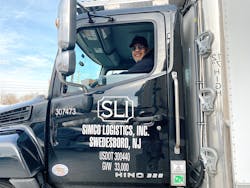Jack & Jill Ice Cream distributor transforms DSD model
Simco Logistics recently rectified its picking, transporting and delivering challenges with the smart use of new technology, leading to dramatic results for the DSD company.
Simco, founded in 1929 as Jack & Jill Ice Cream, uses a DSD model to distribute ice cream and frozen foods, beverages, and deli products to convenience stores, grocery stores and other food retailers throughout the Middle Atlantic.
Guided by Lucas Systems, it upgraded its warehouse technology to turn a number of challenges (inefficient batching, warehouse picking inaccuracies, and the reliance on paper-based reporting) into results that help delivery drivers get the right treats to local stores in the best way possible.
Lucas helps companies work smarter with the use of warehouse optimization and adaptive voice-directed workflows and technologies.
Background
Simco Logistics is a family-owned distributor operating one main distribution center (DC) in Swedesboro, N.J., and shipping to 12 cross-dock facilities that support 110-115 direct store delivery (DSD) routes per day in the Mid-Atlantic U.S. The number of daily routes increases to 135-140 during their peak season between April and September.
As a DSD company, delivery is core to Simco’s mission and success. The company’s services ensure its retail customers have the right products in stock while also reducing their inventory costs and retail labor expenses associated with managing stock and inventory.
To achieve its customer service goals, Simco focuses on improving delivery accuracy and efficiency. That includes upgrading warehouse technology and systems to optimize DC operations, which has downstream benefits for delivery drivers and customers.
“We are always looking for better ways to get the right products packed on our trucks and to make it easier for drivers to make their deliveries,” CEO Ken Schwartz said. “Our drivers are doing more than just dropping off products. They are checking products in and placing them in cases or on shelves. If we can help the drivers get products off the trucks more quickly and accurately, that is a big win.”
Picking and delivery challenges
Products are picked in multiple frozen and refrigerated areas of the Simco warehouse using large rolling racks or pallets that are loaded directly on delivery trucks or trailers. At each stop, drivers pull the items and totes off the racks and pallets and move them by hand cart into the store. At some locations they deliver pallets to customer docks.
Prior to 2019, orders were picked in the DC using printed rack sheets that were generated from information in Simco’s Oracle ERP system. Each paper sheet was made up of multiple customer orders, which were grouped together using detailed rules based on volume, weight and how racks could be loaded on the truck.
Each day, managers would print out rack sheets from the Oracle system, which they would hand out to workers in the DC. Printing, sorting and managing the rack sheets was a two-person job, according to Scott Van de Rijn, director of warehouse and logistics. Supervisors spent the majority of their days managing paper, rather than managing work on the warehouse floor, he says.
Workers used the printed rack sheets to pick products while pushing the wheeled racks through the various frozen and refrigerated areas of the DC. The frozen and non-deli refrigerated items were picked and placed directly on the racks, but they weren’t organized by customer order or stop, which created a challenge for delivery drivers.
After picking, completed racks and pallets were staged on a loading dock, and they were then loaded onto trucks or trailers in a paper-based process. The trailers are driven to the satellite cross dock facilities where items are transferred to local delivery trucks in a manual paper-based process. In the paper-based loading process, racks or pallets occasionally would not be loaded on the correct trailer or truck, which would lead to returns and rush delivery of missing items to the cross docks or customers.
The local delivery process is directly impacted by how orders are picked, packed and loaded on trucks. First and foremost, picking accuracy in the warehouse is key to ensuring orders are delivered complete and in full. With the paper-based processes, picking accuracy was less than 99 percent. “Before Lucas, we were probably at 98% accuracy on a good day,” Schwartz said.
Likewise, how items are sorted and loaded has a direct impact on how efficiently and quickly drivers can do their jobs, Schwartz said. “A driver could be delivering 60 frozen items to a store and has to find those 60 items on the racks,” he said. “That could take 10 or 15 minutes. The ideal is to cut that down to five minutes so that all drivers have to do is grab everything and quickly check it.”
Simco’s leadership team wanted to improve the accuracy and efficiency in the picking and loading processes by moving to an intelligent, voice-directed system. “We wanted to increase accuracy, streamline the process, and eliminate the paper,” Schwartz said.
Intelligent picking and loading
The Simco team evaluated a number of software providers and selected Lucas Systems based on software capability and flexibility, ease of use, integration with Oracle, and other factors.
In addition to creating a paperless voice-directed picking process across the temperature-controlled areas of the DC, Lucas helped Simco add intelligence to create more efficient groupings of orders on the racks, and to subdivide the racks into locations so that items for a given order could be grouped together. Better grouping of orders on the racks was intended to improve the delivery process.
In the new system, Jennifer—the voice and intelligence of the Lucas software—tells pickers what location to pick from, how many to grab, and in which rack location to place the items. In addition, Lucas creates a rack or pallet license plate that indicates which orders and items are on each rack.
“With paper, if we had a rack and we needed five boxes of ice cream sandwiches, we would put those five boxes together in one location on the rack,” Schwartz explained. “With Jennifer, it’s cubed out, and Jennifer will tell the picker what to pick and where to place each of those five boxes on the rack. So each of those 4-5 boxes of ice cream sandwiches are placed on the rack with the rest of the order.”
The Lucas solution also includes a voice-directed loading application. In loading, Jennifer verifies that the correct racks and pallets are loaded on the appropriate truck or trailer, but she does not direct the sequence of loading.
Workers scan the license plate IDs (LPNs) on pallets or racks to confirm what they are loading, and they verbally enter the truck number and tell Jennifer where they are placing the racks on the truck. Jennifer validates the racks and pallets, and she tracks where items are placed. She warns workers if they attempt to load a rack on the wrong truck and she prevents workers from closing a truck or trailer if there are missing racks, pallets or totes.
Based on the information entered during the loading process, Jennifer creates a trailer map showing the location of all racks and pallets on the trucks. The load map aids drivers during delivery or cross-docking from trailers at depots. Drivers also benefit from the Lucas LPNs, which help them identify which racks contain which orders and items so they can off-load items from the trucks faster and more accurately.
In addition to the voice-directed loading and picking applications used by workers, the Lucas solution includes a management console that gives supervisors real-time insight on productivity, workflow, exceptions, and other operational data. Supervisors use the dashboards to manage orders and assign trailers to dock doors, in addition to monitoring performance throughout the shift.
Accuracy and efficiency gains
Since implementing the Lucas solution, picking errors have been reduced by more than 60%. “Right now, we are probably 10 times better than where we were before,” Schwartz said.
“Before, in peak season we would have 300-500 pieces per day that wouldn’t be delivered to customers, for a variety of reasons—damage, driver errors, not on the rack. Now that is down to about 100 pieces a night. We are at 99.8% picking accuracy on many nights.”
In addition, Van de Rijn said loading errors have been almost completely eliminated. “We haven’t had any loading errors in trailers delivered to our satellite facilities,” he said. That has led to less re-delivery of missing items, fewer returns, and less double work picking items that were not delivered.
Picking productivity at Simco has also improved significantly, although that was not the main objective of the project. “We weren’t tracking productivity very closely on paper,” Van de Rijn said. “We knew roughly what different people were doing based on rack counts. And we’ve seen a productivity increase of at least 10-15%.”
Many of the warehouse workers were concerned that the process changes with voice—for example, segregating items by order—might slow them down. Dante Sisto, one of the order selectors at the DC said: “I didn’t think this was ever going to work, but man, I’m faster than I ever was.”
Added Van de Rijn: “After they started using it, workers realized how much quicker it is.”
The warehouse updates, including the truck load maps and rack/pallet LPNs generated by Lucas, have also had downstream benefits, Schwartz said. “The new picking and loading process has also helped DSD delivery drivers save some time at the delivery locations,” he said.
The warehouse uses 50% less paper today and Van de Rijn points to other paper-free benefits for supervisors. “By eliminating paper, we are freeing up the supervisors to get out in the warehouse,” he said. “Before they were really tied down to a desk handing out paperwork.”
Managers are spending more time on the warehouse floor, which has eliminated mistakes and improved the cleanliness of the facility. “It has led to overall better performance in the warehouse,” Van de Rijn concluded.
Simco’s warehouse upgrades have paid off in better service to the locations they serve and also underscore ways to make a DSD model work well to accommodate modern consumer demands.

